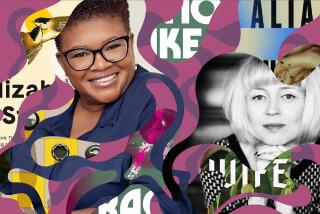Reflections of a Midwestern Literary Eye : Fledgling Chicago-based magazine models itself on the New Yorker, but with decided differences.
- Share via
CHICAGO — On the commute home from his downtown office, David Schabes always leaves a magazine on his seat when he exits the elevated train rumbling west toward O’Hare Airport.
Schabes is not a forgetful man. He leaves the magazine behind every night because he wants other people to read it. Schabes is the editor and publisher of the Midwesterner, a 4-month-old periodical that aims to do for the Midwest what the New Yorker has done for New York--construct a literary and journalistic sensibility shaped through the prism of place.
It is a daunting task in a crowded, segmented marketplace where magazines rear up and expire as quickly as fruit flies. But Schabes insists there is an audience for fiction, true narratives and criticism grounded in what he describes as Midwestern “directness and straightforwardness.”
Schabes, 35, a literature scholar and former nuclear engineer who once edited an atomic energy industry trade publication called Radwaste, is not shy about what he wants his fledgling literary journal to become. Despite featuring classical black-and-white graphics that seem cribbed from the old New Yorker, Schabes defines his magazine by what he sees as the New Yorker’s flaws, which he aims to correct.
The Midwesterner contains no poetry. “I think poetry puts people off,” Schabes said. So, he believes, does excessively graphic “sexual content and vulgar language.” And his reviewers “won’t be writing about opera or classical music because they don’t appeal to a larger audience,” Schabes says. Jazz, country and rock will do just fine.
The more broad-based the better, Schabes believes. Where the New Yorker’s founding editor, Harold Ross, once defined his target audience by saying that it was “not edited for the old lady in Dubuque,” Schabes would welcome her subscription.
“What’s clear to me is that the old lady in Dubuque isn’t what people in the East might think--she’s probably a lot hipper and more creative.” And his magazine, Schabes adds, is aimed as well at the old lady’s “children, who may have moved to New York, Los Angeles or any point in between, but still look at life through a Midwestern perspective.”
*
What exactly a Midwestern perspective is--and whether it stretches from the endless corn plateaus of Kansas to Minnesota’s fields of ice to the trend-setting art garrets and punk clubs of Chicago’s Wicker Park--is a topic that has nettled writers and literary scholars for decades.
To link Ernest Hemingway, F. Scott Fitzgerald, Mark Twain, Theodore Dreiser, Willa Cather, Richard Wright, Hamlin Garland, Sherwood Anderson, Saul Bellow and Toni Morrison in a common literary gene pool might require a tap dance of extraordinary agility. But there are those, such as University of Illinois professor of English James Hurt, who believe that Midwestern literature does have “a sort of unity and integrity that reflects a sense of place.”
When Schabes talks of the Midwest as a “common ground” for literature, he believes there is room enough to include such diverse talents as mainstream novelist Jane Hamilton--whose “The Book of Ruth” was recently lionized by talk show host Oprah Winfrey--and David Foster Wallace, whose sprawling futuristic “Infinite Jest” was one of the literary sensations of 1996.
An essay written by Wallace graces the Midwesterner’s latest issue. And the magazine’s first edition in September contained a story by Hamilton. She sold the tale to Schabes after attempts at publishing it in the New Yorker and other mainstream magazines. “They said it was too long,” Hamilton recalls.
After reading the piece to an audience last year in Chicago, she lamented her inability to sell it. Schabes, who happened to be in the audience, thought it would be the perfect cornerstone for his first issue and contacted her. Hamilton agreed to sell him the story.
Despite her happiness at finding a “magazine that doesn’t always mention Sharon Stone,” Hamilton is not convinced the Midwesterner is immediately poised to unseat the New Yorker. “It sounds like a risky venture, but I sure hope it survives.”
*
Schabes, who put his own money and a retirement nest egg bequeathed by his father into the magazine, believes the Midwesterner, at $5 a copy, will endure if it survives long enough to attract advertisers. So far, only the Starbucks coffee firm and a few smaller advertisers have taken a chance. Citing the popularity of Midwestern Living magazine, a publication aimed more at leisure lifestyle pursuits, Schabes believes the Midwesterner will prevail if it can reach 500,000 households.
Every night, Schabes does his part to reach someone new. It will be there tonight, a crisp copy of the Midwesterner, its front cover facing upward, waiting for the next unsuspecting reader.
More to Read
Sign up for our Book Club newsletter
Get the latest news, events and more from the Los Angeles Times Book Club, and help us get L.A. reading and talking.
You may occasionally receive promotional content from the Los Angeles Times.








